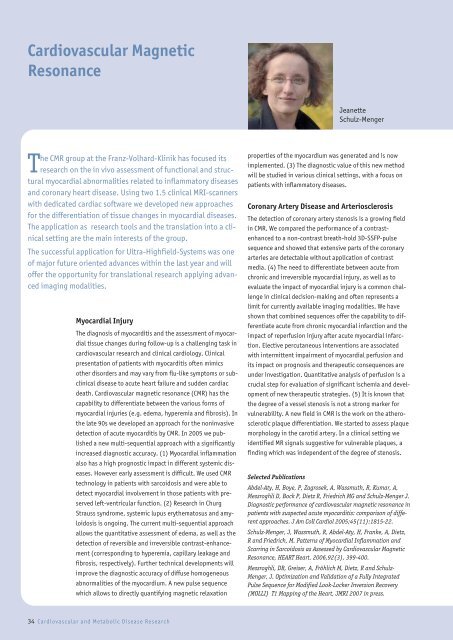of the Max - MDC
of the Max - MDC
of the Max - MDC
You also want an ePaper? Increase the reach of your titles
YUMPU automatically turns print PDFs into web optimized ePapers that Google loves.
Cardiovascular Magnetic<br />
Resonance<br />
Jeanette<br />
Schulz-Menger<br />
The CMR group at <strong>the</strong> Franz-Volhard-Klinik has focused its<br />
research on <strong>the</strong> in vivo assessment <strong>of</strong> functional and structural<br />
myocardial abnormalities related to inflammatory diseases<br />
and coronary heart disease. Using two 1.5 clinical MRI-scanners<br />
with dedicated cardiac s<strong>of</strong>tware we developed new approaches<br />
for <strong>the</strong> differentiation <strong>of</strong> tissue changes in myocardial diseases.<br />
The application as research tools and <strong>the</strong> translation into a clinical<br />
setting are <strong>the</strong> main interests <strong>of</strong> <strong>the</strong> group.<br />
The successful application for Ultra-Highfield-Systems was one<br />
<strong>of</strong> major future oriented advances within <strong>the</strong> last year and will<br />
<strong>of</strong>fer <strong>the</strong> opportunity for translational research applying advanced<br />
imaging modalities.<br />
Myocardial Injury<br />
The diagnosis <strong>of</strong> myocarditis and <strong>the</strong> assessment <strong>of</strong> myocardial<br />
tissue changes during follow-up is a challenging task in<br />
cardiovascular research and clinical cardiology. Clinical<br />
presentation <strong>of</strong> patients with myocarditis <strong>of</strong>ten mimics<br />
o<strong>the</strong>r disorders and may vary from flu-like symptoms or subclinical<br />
disease to acute heart failure and sudden cardiac<br />
death. Cardiovascular magnetic resonance (CMR) has <strong>the</strong><br />
capability to differentiate between <strong>the</strong> various forms <strong>of</strong><br />
myocardial injuries (e.g. edema, hyperemia and fibrosis). In<br />
<strong>the</strong> late 90s we developed an approach for <strong>the</strong> noninvasive<br />
detection <strong>of</strong> acute myocarditis by CMR. In 2005 we published<br />
a new multi-sequential approach with a significantly<br />
increased diagnostic accuracy. (1) Myocardial inflammation<br />
also has a high prognostic impact in different systemic diseases.<br />
However early assessment is difficult. We used CMR<br />
technology in patients with sarcoidosis and were able to<br />
detect myocardial involvement in those patients with preserved<br />
left-ventricular function. (2) Research in Churg<br />
Strauss syndrome, systemic lupus ery<strong>the</strong>matosus and amyloidosis<br />
is ongoing. The current multi-sequential approach<br />
allows <strong>the</strong> quantitative assessment <strong>of</strong> edema, as well as <strong>the</strong><br />
detection <strong>of</strong> reversible and irreversible contrast-enhancement<br />
(corresponding to hyperemia, capillary leakage and<br />
fibrosis, respectively). Fur<strong>the</strong>r technical developments will<br />
improve <strong>the</strong> diagnostic accuracy <strong>of</strong> diffuse homogeneous<br />
abnormalities <strong>of</strong> <strong>the</strong> myocardium. A new pulse sequence<br />
which allows to directly quantifying magnetic relaxation<br />
properties <strong>of</strong> <strong>the</strong> myocardium was generated and is now<br />
implemented. (3) The diagnostic value <strong>of</strong> this new method<br />
will be studied in various clinical settings, with a focus on<br />
patients with inflammatory diseases.<br />
Coronary Artery Disease and Arteriosclerosis<br />
The detection <strong>of</strong> coronary artery stenosis is a growing field<br />
in CMR. We compared <strong>the</strong> performance <strong>of</strong> a contrastenhanced<br />
to a non-contrast breath-hold 3D-SSFP-pulse<br />
sequence and showed that extensive parts <strong>of</strong> <strong>the</strong> coronary<br />
arteries are detectable without application <strong>of</strong> contrast<br />
media. (4) The need to differentiate between acute from<br />
chronic and irreversible myocardial injury, as well as to<br />
evaluate <strong>the</strong> impact <strong>of</strong> myocardial injury is a common challenge<br />
in clinical decision-making and <strong>of</strong>ten represents a<br />
limit for currently available imaging modalities. We have<br />
shown that combined sequences <strong>of</strong>fer <strong>the</strong> capability to differentiate<br />
acute from chronic myocardial infarction and <strong>the</strong><br />
impact <strong>of</strong> reperfusion injury after acute myocardial infarction.<br />
Elective percutaneous interventions are associated<br />
with intermittent impairment <strong>of</strong> myocardial perfusion and<br />
its impact on prognosis and <strong>the</strong>rapeutic consequences are<br />
under investigation. Quantitative analysis <strong>of</strong> perfusion is a<br />
crucial step for evaluation <strong>of</strong> significant ischemia and development<br />
<strong>of</strong> new <strong>the</strong>rapeutic strategies. (5) It is known that<br />
<strong>the</strong> degree <strong>of</strong> a vessel stenosis is not a strong marker for<br />
vulnerability. A new field in CMR is <strong>the</strong> work on <strong>the</strong> a<strong>the</strong>rosclerotic<br />
plaque differentiation. We started to assess plaque<br />
morphology in <strong>the</strong> carotid artery. In a clinical setting we<br />
identified MR signals suggestive for vulnerable plaques, a<br />
finding which was independent <strong>of</strong> <strong>the</strong> degree <strong>of</strong> stenosis.<br />
Selected Publications<br />
Abdel-Aty, H, Boye, P, Zagrosek, A, Wassmuth, R, Kumar, A,<br />
Messroghli D, Bock P, Dietz R, Friedrich MG and Schulz-Menger J.<br />
Diagnostic performance <strong>of</strong> cardiovascular magnetic resonance in<br />
patients with suspected acute myocarditis: comparison <strong>of</strong> different<br />
approaches. J Am Coll Cardiol 2005;45(11):1815-22.<br />
Schulz-Menger, J, Wassmuth, R, Abdel-Aty, H, Franke, A, Dietz,<br />
R and Friedrich, M. Patterns <strong>of</strong> Myocardial Inflammation and<br />
Scarring in Sarcoidosis as Assessed by Cardiovascular Magnetic<br />
Resonance, HEART Heart. 2006,92(3), 399-400.<br />
Messroghli, DR, Greiser, A, Fröhlich M, Dietz, R and Schulz-<br />
Menger, J. Optimization and Validation <strong>of</strong> a Fully Integrated<br />
Pulse Sequence for Modified Look-Locker Inversion Recovery<br />
(MOLLI) T1 Mapping <strong>of</strong> <strong>the</strong> Heart, JMRI 2007 in press.<br />
34 Cardiovascular and Metabolic Disease Research
















